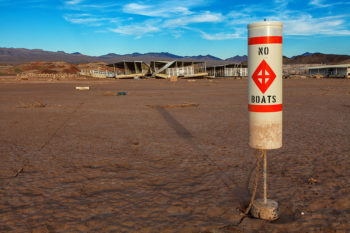There’s no “Sweet Spot” – What the Colorado River Needs is “Real Balance”
The real problem isn’t one water user striving to achieve a “sweet spot” in reservoir levels to maximize its own water use; it’s the failure so far of the basin states to adjust to the new hydrology. Region-wide aridity and a warming climate just might force that hand for them.
![Bathtub rings can be seen along Lake Mead in 2006. | Chris Richards [FlickrCC]](https://www.americanrivers.org/wp-content/uploads/2018/04/395742119_89e6d6a97f_b.jpg)
Over the last week, those of us who eat, sleep, and drink Colorado River issues have watched with alternating measures of surprise, concern, and alarm as water users from the Upper Basin states publicly called out the operators of the Central Arizona Project (CAP) for “gaming” reservoir levels to maximize water deliveries to Arizona. The worry is that CAP’s efforts to find a “sweet spot” in managing the Colorado River has the effects of undoing nearly a decade of collaborative conservation successes and threatens to pull the entire Basin into shortage more quickly than is already likely.
Media coverage of this dustup has been welcome, highlighting the complexity and conflicting motivations at the heart of efforts to manage the Colorado River as a water supply for seven states and 40-plus million people. The states and major water users along the river agreed in 2007 to a set of guidelines that spelled out collaborative responses to drought and shortages in water supply. But these guidelines don’t resolve the tension between an ethic of “we’re all in it together” and the long-practiced tendency of each state to maximize their own water use. More critically, the guidelines are a good effort to respond to short-term drought, but deftly avoid the substantive management changes needed to address permanently diminished flows associated with long-term aridity.

Conflict between states and water users is regrettable, but more so, there is a missed opportunity within ongoing multi-state negotiations to fully acknowledge what all of us privately admit… there isn’t going to be enough water in the Colorado River in the future to fulfill all of the previously made promises. If the Colorado basin ever really provided a reliable fifteen to seventeen million-acre-foot (MAF) supply, those days were brief, and they are long gone. The consensus of climate science and hydrology points toward a future in which Colorado River flows total 12 MAF or less, perhaps as low as 9 MAF. The real problem isn’t one water user striving to achieve a “sweet spot” in reservoir levels to maximize its own water use; it’s the failure so far of the basin states to adjust to the new hydrology. Region-wide aridity and a warming climate just might force that hand for them.
In this regard, Arizona certainly could be doing more. Individual users of Colorado River water, some of the major urban water providers, and an irrigation district or two, have shown innovation and commitment to conserving water and creating more flexible tools for sharing their water resources. Likewise, cities in southern Nevada and southern California have demonstrated real foresight, either in reducing demand or developing resilient local water supplies as alternatives to uncertain and declining Colorado River imports. But as a whole, the states that share the river haven’t yet shown a full commitment to solving the underlying problem of getting by with a smaller share of Colorado River water.
If there’s a silver lining in last week’s airing of dirty laundry, maybe, just maybe, it’s in the way the family feud has highlighted our need to get to the real issues. As the basin looks toward negotiations around a new set of operating guidelines to succeed those adopted in 2007, let’s hope they can bring a spirit of innovation and honest, intentional, collaboration to meet this challenge.




1 response to “There’s no “Sweet Spot” – What the Colorado River Needs is “Real Balance””
The ongoing and continuing saga an epic one at that that continues to be the most concerning of issues, of Water Resources and Habitats, and Ecosystems, Biodiversity, Sustainability, to help our resources together with Conservation, and Protecting Species and our Wildlife today.